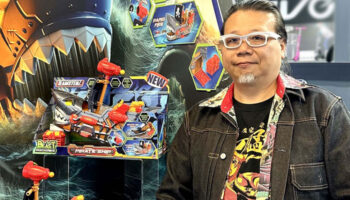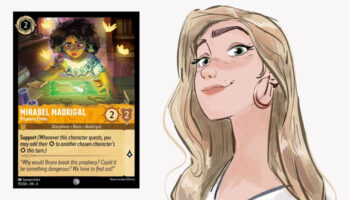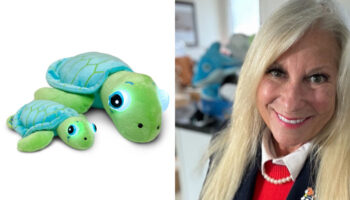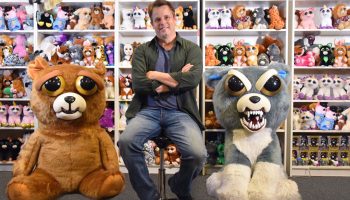Reyn Guyer – inventor of classics like Twister and the Nerf Ball – on creativity, collaborations and his new venture, My Friend Wren
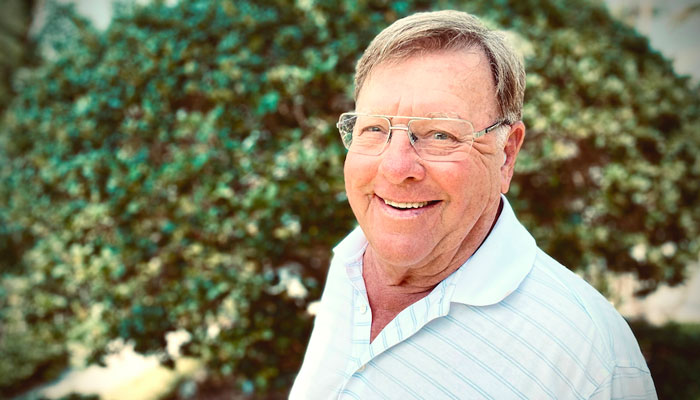
Reyn Guyer has always believed that play is an essential part of being happy in life – which is why he has made a career out of creating great toys and games.
Among his many successes are two products that have become industry icons – Twister and the Nerf ball – as well as a book, Right Brain Red: 7 Ideas for Creative Success, co-written with Tim Walsh.
Reyn’s latest venture is My Friend Wren, an online platform and YouTube channel showcasing creative and gentle children’s stories and songs, all sung and narrated by Reyn himself.
We caught up with Reyn to talk Twister, Nerf and his plans for My Friend Wren moving forwards.

Reyn, it’s a honour to catch up with you. You’ve invented iconic toys and games over the years that have well and truly become part of popular culture. Was a career in play always on the cards?
When I graduated from college, my father had just started a new design business. They were designing new packaging for people in the paper carton business and making aisle displays that promote Fortune 500 companies’ products.
I had been an English major and had done lots of short stories to get me my honours credits. I was planning to be a writer but my dad said, “Come work with me,” and I said okay. I learned about the business and the more I learned about the business the more I realised that I didn’t see long term opportunities there.
I kept looking for other opportunities and most were a bit ridiculous. I tried my hand at the pizza business but thank god I got out of that because I didn’t know anything about food or franchising! Then, one day, I was working on an idea for a shoe polish client and was thinking about a paper mat that kids could sit on and also play a game with. I realised there was more opportunities here because there weren’t any games where kids themselves were the play pieces.
Following that lightbulb moment, how did Twister take shape?
Well, I pulled out a big sheet of corrugated board and drew one-foot squares on it, in a 6 x 4 pattern. We got eight of us on the mat. We put ourselves into four teams positioned at each corner, and it was a race for them to reach the other side first. If someone was in your way, you couldn’t step on their square, so you had to go around them. When we played it, we were laughing so hard that you could see right away that it had nothing to do with the rules of the game, it was simply F-U-N.
I developed the game, called it King’s Footsie and took it to a games company that we were close to because we made their displays. They had a very sophisticated line of really good games, and they thought our game was great, but said they didn’t do our type of game.
We then hired a couple of guys to start up a new division of our company focused on inventing games. I talked my dad into underwriting this for a couple of years and, to his great credit, he saw that I was working on something that was different and unusual.
The result of this was that we came up with around 10 games where people were the play-pieces. We took them to Milton Bradley, to a gentleman by the name of Mel Taft, who was head of development there. He liked the one which had dots where on the floor, in a line, in different colours, and that happened to be a game we called Pretzel.
They decided they wanted to launch it with a new name, Twister, but then, in the Christmas of 1966, Mel called me and said “Reyn, I have bad news. We’re not going to come out with the game. The largest seller of toys and games has just told us that it’s an inappropriate game.” It was disappointing, but Mel had already paid a PR company to get the game onto The Johnny Carson Show. Mel and the PR lady were sitting in the audience when Eva Gabor enticed Johnny onto the Twister mat… It took off from there and the rest is history.

Amazing! You mention about Mel Taft there; how important was it to have someone like him championing the game at Milton Bradley?
Without Mel Taft, the game would not be. All of the other executives at Milton Bradley moved on from Twister once they heard that retailer wasn’t going to take it. Mel, to his great credit, didn’t give up on it. Since he’d already paid to get it on The Johnny Carson Show, he thought ‘Why not, let’s give it a go!’ Mel had a sense of fun and was a dear life-long friend. At the 2012 TAGIE Awards, I read his speech when he was not well enough to go. It was an honour to do that, and he was a dear friend.
When you read about the history of the game, there’s always quite a lot made of the ‘sex-in-a-box’ tag and how it was seen as quite a risqué game at the time. How much truth is in that?
It is what it is! One of the co-inventors, Chuck Foley, said ‘Dirty mind, dirty game!’ It’s still played at kids’ birthday parties – and that’s the primary use of it. Although people have come up to me in the past to tell me stories of their activities on a Twister mat which we will not get into here.

Ha! Thanks for sparing me that! The game is now a staple of popular culture; how soon did you realise that Twister was going have a special, enduring appeal?
It’s had an up and down career, although never way down, but for a while it dropped off a little bit. Milton Bradley was very good at reminding their audience that Twister was there and it was valuable and fun. Back then, games did fall off the shelf after seven or eight years, but that team did a great job of keeping it going.
Most inventors would hope they have a Twister in them, but you actually have two toy classics under your belt, as you also invented the Nerf ball, which went on to spawn that huge brand. How did that idea come about?
Well, shortly after Twister, I amicably left the company that my father and I had been running and started a new company called Windsor Concepts. We began developing ideas and a year into the business, one of the guys had an idea for a game where the pieces on the floor looked like rocks, and you had to hide your money under a rock. Other players would walk around and try to steal your money, but we had to figure out a way that you could stop players doing that – maybe you could shoot them with something?
There was some black foam that used to be used as padding when moving valuable merchandise in transit. He cut out a few of those pieces, we took three pieces each and we’d throw it at each other to stop people stealing your money. It was a lousy game that didn’t make any sense at all! That said, I really believe that you shouldn’t diss something before you’ve tried it; you really have to make one. It doesn’t matter if it doesn’t work, something else might come from it.
So, we did it, we made one… And the game was still lousy! Then one of the team, Will Cruise, started bouncing one of these rocks over a net. We looked at each other and said “Oh!” We went to our desks and started cutting out bits of foam to make them into balls. We created different sizes and took a bunch of related ideas to Milton Bradley. They told us they weren’t a toy company; they were strictly a games and puzzles company.
I took it to Henry Simmons at Parker Brothers – he was head of new product development there. He rang me shortly after and said: “We like this, but we’re just going to do the ball.” That didn’t make any sense to us, but he said they’d put it in a box and see how it goes. It sold a few million and from there, we showed them more ideas and other people showed them ideas and it built into the Nerf line we see today.

We’ve spoken about Nerf and Twister, and I imagine you get asked about them quite a lot, so is there any other invention of yours that you think should be getting the limelight? What should I be asking you about instead?
There are some other products that we’ve had on the market, but the one I’d pick would be the one I’m working on right now! It’s a new brand called My Friend Wren.
Yes! You were kind enough to send me a few links to this and it sounds lovely. Talk us through My Friend Wren.
It’s a collection of stories and songs that I have written, put to music by Jeff Harrington. Jeff worked at our music company, WrenSong, as one of the writers there. He’s a wonderful, fabulous production musician; we’ve worked together since 1985 and continue to do so. At one time, we had a collection of our stories and songs out on the market under a character by the name Curly Lasagne – we released them Curly Lasagne’s Car Tapes. I did the singing; Jeff did the music and I still have people asking me for them – they say they grew up on Curly Lasagne.
All the feedback encouraged me to go back at it, only this time I’ve had some artists from KidShannon in New York take these stories and songs and illustrate them. We also have Todd Obernolte, our videographer, and so we’ve created videos for all our stories and songs. They’re up on YouTube and here I am again in the kids’ business because this thing is really starting to cook!
Amazing! We’ll put one of the videos in here so people can have a watch.
You said it’s starting to cook; what are your expectations for the brand?
Well, we set some goals when we started about nine months ago to hit certain subscriber levels, and we have surpassed all the benchmarks we set ourselves. Now the focus is on making sure people see them and get to them.
This space is an incredibly crowded one – what sets My Friend Wren apart?
Our material is not like the usual kids’ stuff that’s fast and quick and frantically trying to keep their attention. We’ve gone down a different path – which I have spent a lifetime doing – and it seems to be working. People watch our songs from start to finish and that’s very gratifying and quite unusual on YouTube! We also hope that kids watch it with their parents. Parents are often entranced by the stories too, which is also gratifying.
I should mention too that we also have a site at www.MyFriendWren.com which is broader than the YouTube channel and goes into where it comes from. We’re having so much fun with this that we’re also looking at ancillary materials like storybooks.
And toys?
Ha! You’ve got it, Bill. As we go on, the more subscribers we get, the greater the opportunity is for us to bring this world into toys and storybooks. The depth of the material is deep enough to expand upon – and have some fun while doing it!
Why do you think you’re drawn to working in play, and on playful projects?
I really don’t know, but I have the gift of being able to see what’s fun, what’s unusual and what’s different. I probably haven’t grown up! I love making fun things, but I like to make things different. My friends think “Oh Reyn does that strange stuff… I’m not sure what he really does.”
Before we wrap up, I wanted to ask if there’s any one element that you think all your inventions share?
Well, I’ll put it this way. There’s a very popular game out that sells a lot of units. You add scores individually on a piece of paper according to the roll of some dice… You know the game! I’ve always thought it’s really boring. Nobody is involved in anyone else’s turn! One given for me whenever I’m designing a toy or game is that all players involved in the game should be interested in everybody’s turn. If you’re not interested in somebody else’s shake, then you’re stuck waiting for your turn.
I developed a game called Rally Roll. It’s a dice game but they don’t look like regular dice. You get eight people around the table and it’s just plain noisy! People are yelling at each other when someone else are shaking and everyone is invested in what’s going on.

I also created a lawn game called King’s Court. It was on the market for a while, but it was much too expensive to produce and I haven’t gone back to it yet. I’ve always thought croquet was boring. No-one cares what anyone else is doing and sometimes they’re not even sure who’s turn it is! King’s Court sees two teams try to knock over each other’s guards in order to get to the King. More time is spend with teams discussing what they want to do than is spent actually hitting a ball, so it’s fun because everyone is involved.
You must get budding inventors approach you all the time for advice. Is there one pearl of wisdom you find yourself telling them?
If you’re going to try to develop new products, don’t do it yourself – it’s really hard. There are people who have had success on their own, but I’d say work with a team of two, three, four or five people. Any more than that and you have a committee, and a committee is almost totally incapable of coming up with something creative. Working in a team is so important because you can bounce ideas off each other and build off each other.
My second piece of advice is if the team seems to have a good idea, stop right there! Do not sit around the table and discuss what could be wrong with it or what the problems could be. Go and make one. In making one, you’ll find out if it works and while you’re making the model, you’ll likely stumble across something else that could be even more valuable. Magic happens when you’re doing. It doesn’t happen while you’re sat around talking about it. Make one. Do it!
Great advice. Right, one last question! Is there anything you do that you find helps you have ideas?
There are ideas in the wind. You’ll see people thousands of miles apart coming up with very similar ideas because they are in touch with what’s going on. We’re all responding to culture and what we see happening and what we see people are doing. It’s in the wind; it’s in all of us.
Reyn, this has been a pleasure and an honour. Huge thanks for making time and I look forward to catching up again soon.
—
To stay in the loop with the latest news, interviews and features from the world of toy and game design, sign up to our weekly newsletter here





